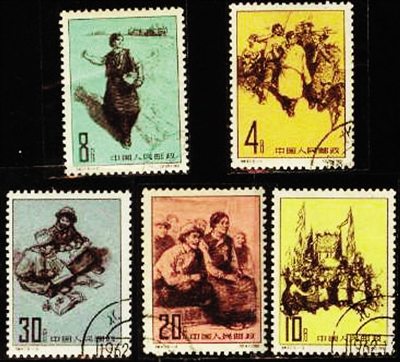
In 1961, a set of Tibet-themed stamps named Rebirth of the Tibetan people were issued by China's Ministry of Posts and Telecommunications. [Photo/Agencies]
Postal service in Tibet, according to the historical records and works on history of postal service, was established in the Yuan Dynasty (1279-1368) and gained further development in the Qing Dynasty(1636-1911).
In the winter of 1909, a postal zone headquartered in Lhasa was set up under the administration of Qing Dynasty and later on had branches in Chamdo, Yadong, and Gyantse.
In April of 1911, the stamps were released into the market with the whole set consisting 11 pieces of stamps in three languages including Han Chinese, Tibetan, and English. They were priced in three kinds of currency, the silver coin, Indian rupee and Tibetan coins.
In the same year, the Qing administration established the first full-time public organization and stamps became popularized, as can be traced in historical records and stamp collections of philatelists.
The printing technology of Tibetan stamps was very primitive, as it was merely to satisfy the basic postal needs. Therefore, there were subtle yet many differences of the stamps in terms of color, ink and texture because of the immature workmanship.
In 1914, two pieces of stamps were issued with a bigger face value, namely the four tangka and eight tangka (tangka, a silver coin in Nepal and began to circulate in Tibet since the 16th century).
In 1933, a new set of stamps were issued in a bigger shape than the previous ones and looked more Asian-style in shape. Later on perforated stamp were issued. Around 1950, official stamps and telegraph stamps were issued.
